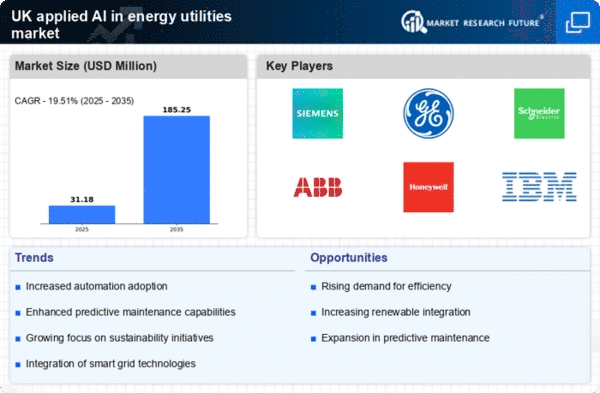Technological Advancements in AI
Technological advancements in AI are significantly shaping the applied ai-in-energy-utilities market in the UK. Innovations in machine learning, data analytics, and IoT are enabling utility companies to harness vast amounts of data for improved decision-making. The development of sophisticated algorithms allows for enhanced predictive maintenance, grid optimization, and customer engagement strategies. As AI technologies continue to evolve, their applications within the energy sector are becoming more diverse and impactful. For instance, AI can analyze historical data to predict equipment failures, thereby reducing downtime and maintenance costs. The ongoing advancements in AI are likely to drive the applied ai-in-energy-utilities market, as companies seek to leverage these technologies to enhance operational efficiency and customer satisfaction.
Investment in Smart Infrastructure
Investment in smart infrastructure is a pivotal driver for the applied ai-in-energy-utilities market in the UK. The government and private sector are increasingly allocating funds towards the development of smart grids and advanced metering systems. According to recent reports, the UK is expected to invest over £20 billion in smart energy infrastructure by 2025. This investment is aimed at enhancing the resilience and efficiency of energy systems, enabling real-time data collection and analysis through AI technologies. The integration of AI into these infrastructures allows for improved demand forecasting, grid management, and energy distribution. Consequently, this trend not only supports the operational capabilities of utility companies but also aligns with the broader goals of sustainability and energy efficiency. The ongoing investment in smart infrastructure is likely to propel the growth of the applied ai-in-energy-utilities market significantly.
Regulatory Support for AI Adoption
The applied ai-in-energy-utilities market in the UK is experiencing a surge in regulatory support aimed at fostering innovation and sustainability. The UK government has introduced various initiatives to promote the integration of AI technologies within the energy sector. For instance, the Energy Digitalisation Strategy outlines a framework for leveraging AI to enhance operational efficiency and reduce carbon emissions. This regulatory backing is crucial as it encourages utility companies to invest in AI solutions, potentially leading to a market growth rate of approximately 15% annually. Furthermore, the commitment to achieving net-zero emissions by 2050 necessitates the adoption of advanced technologies, including AI, to optimize energy consumption and management. As such, the regulatory environment is a significant driver for the applied ai-in-energy-utilities market, facilitating the transition towards a more sustainable energy landscape.
Rising Demand for Renewable Energy
The increasing demand for renewable energy sources is a critical driver for the applied ai-in-energy-utilities market in the UK. As the country aims to transition away from fossil fuels, the integration of AI technologies becomes essential for managing the complexities associated with renewable energy generation and distribution. The UK government has set ambitious targets, aiming for 70% of electricity to come from renewable sources by 2030. This shift necessitates advanced AI solutions to optimize energy production, storage, and consumption. AI can facilitate better integration of variable renewable energy sources, such as wind and solar, into the grid, enhancing reliability and efficiency. The growing emphasis on renewables is expected to create substantial opportunities for AI applications in energy management, thereby driving the applied ai-in-energy-utilities market forward.
Consumer Demand for Energy Efficiency
Consumer demand for energy efficiency is increasingly influencing the applied ai-in-energy-utilities market in the UK. As households and businesses become more environmentally conscious, there is a growing expectation for utility providers to offer solutions that enhance energy efficiency. AI technologies play a crucial role in this context by enabling personalized energy management systems that help consumers monitor and reduce their energy usage. Reports indicate that energy-efficient solutions can lead to savings of up to 30% on energy bills. This shift in consumer behavior is prompting utility companies to adopt AI-driven tools that provide insights into energy consumption patterns and suggest optimizations. As a result, the applied ai-in-energy-utilities market is likely to expand as companies respond to this demand for smarter, more efficient energy solutions.

















Leave a Comment